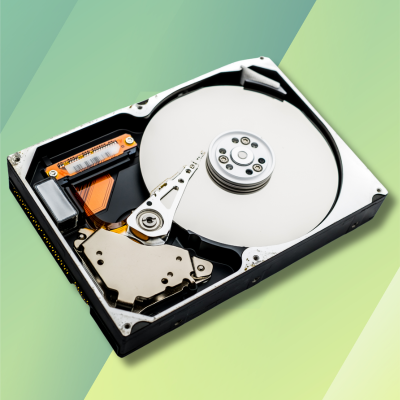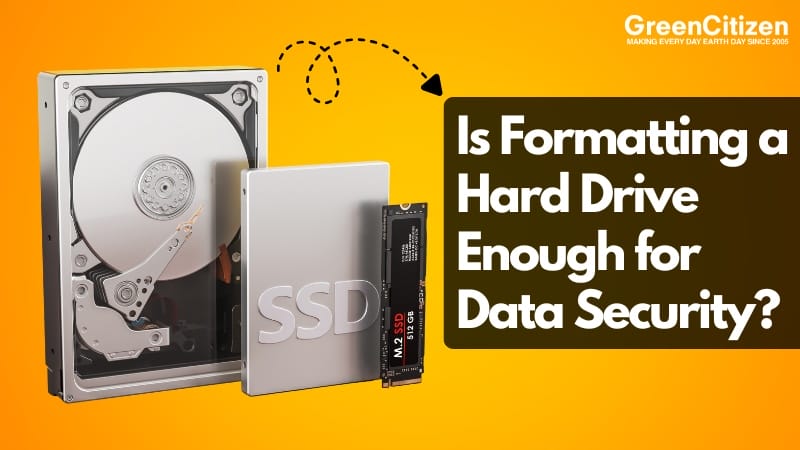When people sell or recycle old computers, the most common first step is to “format the hard drive”—believing it wipes everything clean.
But in reality, formatting only removes the file system references, not the actual data stored on the drive’s sectors. That means documents, passwords, and even deleted photos can still be recovered with free forensic tools, leaving your personal or business information exposed.
So, is formatting a hard drive enough for data security?
No. Formatting your HDD or SSD only hides data from the operating system—it doesn’t destroy it. Anyone with basic recovery software can extract what’s left behind.
To keep sensitive data safe, especially when disposing, recycling, or donating laptops and desktops, you need to understand how formatting works, what it doesn’t do, and which secure data erasure methods truly protect you from identity theft and compliance risks.
Key Takeaway: Is formatting a hard drive good enough for data security?
Formatting a hard drive isn’t enough for data security. It only removes file system references, leaving data recoverable with basic tools. To truly protect information, use secure erase or certified data wiping methods that permanently overwrite or destroy stored data beyond recovery.

Hard Drive Data Destruction by GreenCitizen
- Follows NIST 800-88 Rev.1 guidelines.
- Approved by DoD standards.
- Total accountability — make, model, and serial number recorded.
How Formatting Works (and What It Really Does to Your Data)
When you format a hard drive or SSD, the operating system doesn’t actually erase your files — it only removes the map that tells the computer where your data lives. Think of it as tearing out the table of contents, while all the chapters are still intact in the book.
Most modern systems, including Windows and macOS, offer two main options:
- Quick Format — simply deletes the file system references (like the FAT or NTFS table) and marks space as “available.”
- Full Format — scans the drive for bad sectors and may overwrite some metadata, but doesn’t guarantee complete data removal.
Unlike zeroing — which physically overwrites every storage block with new data — formatting simply marks sectors as empty without touching their underlying content. This distinction between marking and zeroing is why formatted drives can still hold recoverable information.
Does formatting overwrite all the data on the drive?
No. A standard format doesn’t overwrite every sector. The data remains until it’s overwritten by new information — which can take weeks or months of normal usage. That’s why data recovery tools can reconstruct files from these “empty” sectors long after formatting.
In the case of solid-state drives (SSDs), the problem is even trickier. Due to wear-leveling and over-provisioning, an SSD’s controller moves data between cells to balance usage. This means even if you perform a full format, some blocks that contain old data might never be overwritten.
So while formatting gives you the illusion of a clean slate, forensic tools can still retrieve files, cached data, browser histories, or personal records hidden deep within the drive’s unallocated space.
⚙️ In short: Formatting a hard drive only marks drive sectors as free; it doesn’t overwrite or sanitize stored data. For true data security, use certified wiping tools or hardware-based secure erase methods instead.
Why Formatting A Hard Drive Isn’t Enough for Data Security
Formatting might make a drive look empty, but beneath that clean interface lies a massive security blind spot. The reality is that formatted drives often still contain recoverable data — everything from photos and tax records to corporate databases and login credentials.
When a drive is formatted, only the file allocation tables are cleared. The actual binary data — the 0s and 1s that represent your files — remain intact on the disk’s physical sectors. That’s why data recovery software or forensic tools can scan these sectors and rebuild previously “deleted” files with surprising accuracy.
What risks can arise from reusing or selling a formatted drive?
Even after formatting, sensitive information such as financial spreadsheets, cached emails, browser passwords, and business documents can be retrieved. Cybercriminals frequently buy secondhand drives from online marketplaces to mine this leftover data for identity theft, fraud, or corporate espionage.
The risks aren’t limited to individuals. For businesses, improperly sanitized drives can lead to data breaches, privacy law violations, and regulatory penalties under frameworks such as HIPAA, GLBA, GDPR, or CCPA. In many jurisdictions, companies are legally required to ensure data destruction before disposal or resale of any storage device containing personal or customer data.
Recent studies and industry audits have shown that over 40% of used hard drives sold online still contain recoverable data — a clear reminder that formatting alone doesn’t meet data sanitization standards.
🔐 Key insight: Formatting creates a false sense of security. Without verified data wiping or physical destruction, you’re essentially leaving your personal or business information unlocked for whoever accesses that drive next.
Secure Alternatives: How to Truly Erase Data from Hard Drives and SSDs
If formatting isn’t enough, what actually works? True data sanitization goes beyond hiding files — it permanently destroys all traces of information at the physical level. Depending on the type of drive, the best method can vary, but they all share one goal: rendering your data completely unrecoverable.
1. Use Certified Data Wiping Tools
For traditional hard drives (HDDs), specialized software like Blancco Drive Eraser, DBAN (Darik’s Boot and Nuke), or CCleaner Drive Wiper overwrites every storage sector with random data or zeroes.
This process—often called data wiping or zero-fill erasure—ensures that no original data remains readable, even under forensic recovery.
2. Trigger Built-In Secure Erase Commands
Most modern SSDs and NVMe drives include firmware-level commands such as ATA Secure Erase or NVMe Sanitize. These instructions tell the controller to electronically purge every NAND cell, including those hidden in over-provisioned areas that normal formatting cannot reach.
Unlike HDD wiping, this method is instant, controller-level, and specifically designed for flash memory behavior.
3. Verify the Erasure
After wiping, verification is key. Many enterprise-grade tools provide a data erasure certificate—a verifiable log that confirms every sector has been successfully overwritten. This certificate can be critical for compliance audits under standards like NIST 800-88, ISO/IEC 27040, and DoD 5220.22-M.
4. Physically Destroy Drives That Contained Highly Sensitive Data
For devices storing confidential, medical, or financial information, physical destruction remains the gold standard. Methods include drive shredding, degaussing, crushing, or disintegration—each ensuring the magnetic platters or NAND chips are permanently damaged beyond recovery.
Certified recyclers use industrial shredders or magnetic degaussers to achieve this safely and sustainably.
Is secure erasure always necessary for home users?
Not always. If your old drive held only non-sensitive files and you’re reusing it personally, a single-pass overwrite or built-in secure erase may be enough. But for drives leaving your possession—through sale, donation, or recycling—secure erasure or destruction is non-negotiable.
🧭 Best Practice: Before parting with any storage device, confirm complete data sanitization using trusted software or certified recyclers. A few extra minutes can save years of potential identity theft or compliance exposure.

Hard Drive Data Destruction by GreenCitizen
- Follows NIST 800-88 Rev.1 guidelines.
- Approved by DoD standards.
- Total accountability — make, model, and serial number recorded.
When You Should Use Stronger Measures or Physical Destruction
Even the best digital erasure methods have limits — and for certain kinds of information, nothing short of physical destruction is acceptable. If a drive has ever contained sensitive personal, financial, or corporate data, secure destruction isn’t just recommended — it’s a compliance obligation.
1. For Drives Containing Extremely Sensitive Data
If your device stored financial records, medical files, trade secrets, or other critical intellectual property, simple wiping may not provide sufficient assurance. In such high-risk cases, physical destruction is recommended only when software sanitization can’t guarantee total data erasure — for example, when drives are damaged, encrypted, or contain bad sectors that prevent overwriting.
Organizations in regulated sectors such as healthcare, finance, education, and defense often use physical destruction as a secondary safeguard to eliminate any chance of residual recovery.
2. When Legal, Regulatory, or Contractual Requirements Apply
Frameworks such as HIPAA, GLBA, GDPR, CCPA, and NIST 800-88 emphasize verified data destruction — not necessarily shredding, but proof that data is permanently unrecoverable.
If a company cannot validate the effectiveness of its software-based sanitization (e.g., due to drive corruption or lack of audit documentation), then physical destruction becomes the compliant fallback method.
Partnering with a certified IT asset disposition (ITAD) vendor ensures the entire chain of custody is logged, documented, and fully auditable — protecting you from compliance risks, legal exposure, and data recovery incidents.
Physical Destruction Methods That Guarantee Irreversibility
When the risk level is high, these methods provide total data sanitization:
- Shredding: Industrial shredders tear drives into small fragments, destroying platters and chips.
- Degaussing: Uses a powerful magnetic field to disrupt the data stored on magnetic media.
- Crushing or Punching: Mechanically breaks the platters or NAND cells beyond repair.
- Incineration or Disintegration: Used in high-security environments where total material destruction is required.
Each of these methods ensures that even advanced forensic tools cannot extract usable data. Certified recyclers typically combine destruction with environmentally responsible e-waste recycling for compliance and sustainability.
Obtain Certification and Audit Trail
Always request a Certificate of Data Destruction or Asset Disposal Report from your ITAD provider. This documentation serves as proof of compliance during audits and protects your organization from liability if a future data leak is traced to disposed hardware.
When Is Physical Destruction the Only Safe Option?
Physical destruction becomes the only safe option when software-based data sanitization cannot be fully verified or completed.
This includes cases where the drive is physically damaged, corrupted, encrypted, or contains bad sectors that prevent secure overwriting — or when a company’s compliance framework explicitly requires destruction as the final safeguard.
For drives that once held regulated or highly confidential information — such as medical records, financial data, or client databases — destruction may be mandated only if secure erasure cannot guarantee irrecoverable data removal under standards like NIST 800-88, HIPAA, or GLBA.

Hard Drive Data Destruction by GreenCitizen
- Follows NIST 800-88 Rev.1 guidelines.
- Approved by DoD standards.
- Total accountability — make, model, and serial number recorded.
Final Verdict: Formatting Isn’t Data Security — It’s a False Sense of Safety
Formatting a hard drive might make your screen look clean, but it doesn’t make your data disappear. Beneath that fresh partition lies recoverable information — everything from photos and passwords to confidential business records — waiting for the right tool or the wrong person to find it.
True data protection requires more than a quick format. Whether you’re an individual recycling an old laptop or a company decommissioning hundreds of drives, only verified data wiping, secure erase commands, or certified physical destruction can guarantee complete information sanitization.
Ignoring this step isn’t just careless — it’s a potential data breach waiting to happen, one that can lead to identity theft, financial fraud, or regulatory penalties under laws like HIPAA, GDPR, and CCPA. The safest route is simple: treat every drive as if it still contains sensitive data until it’s securely wiped or destroyed.
